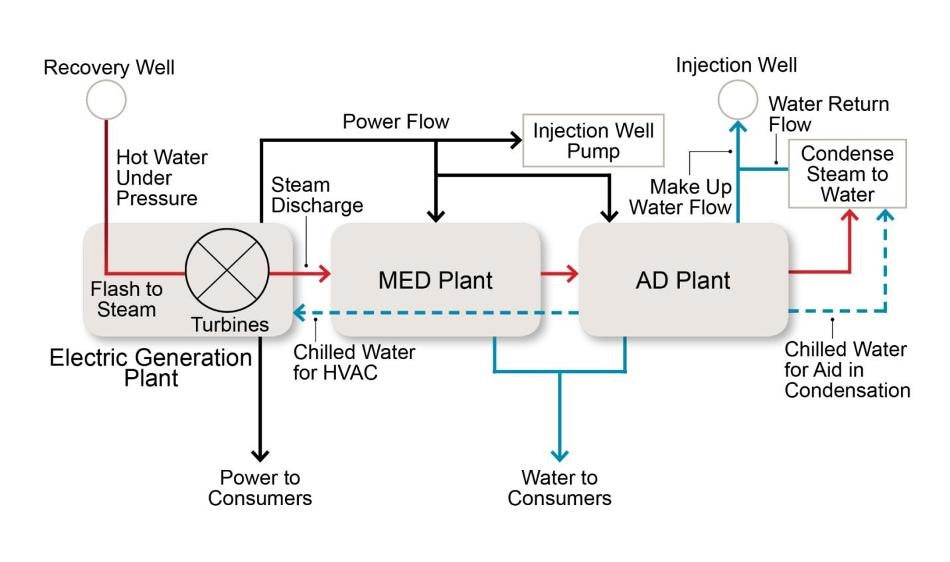Nov 5 2018
Certain regions of the world are affected worst by water shortages, and with rising global temperatures, many more areas may be experiencing drought conditions.
 Diagram of how the geothermal energy would be used for energy production, and two types of desalination (MED and AD). Red lines indicate hot water, while blue lines are cooled water. At the end of the process, distilled water would be available for consumers and aquifer storage, and the chilled water could be used in air conditioning for the plant. The whole theoretical system is carbon-neutral. (Image credit: Thomas Missimer)
Diagram of how the geothermal energy would be used for energy production, and two types of desalination (MED and AD). Red lines indicate hot water, while blue lines are cooled water. At the end of the process, distilled water would be available for consumers and aquifer storage, and the chilled water could be used in air conditioning for the plant. The whole theoretical system is carbon-neutral. (Image credit: Thomas Missimer)
Countries like Saudi Arabia depend more on desalination plants to supply drinking water to their residents, synthesizing five million cubic meters of desalinated water every day. The technique requires a high amount of energy, which could restrict the application of the process in various parts of the world.
Scientists have been working on applying renewable energy sources like wind and solar to power desalination plants, and minimize the need for conventional, fossil-fuel-powered techniques. At present, an innovative study presents an unexploited resource for powering desalination—geothermal energy.
We’re searching the world right now for better methods, low carbon methods, to create energy. We want electricity that’s generated at base load—in other words, generated 24 hours a day without interruption. Geothermal is one of those types of energies.
Thomas Missimer, Florida Gulf Coast University.
According to Missimer, geothermal offers energy in two ways: dry rock and wet rock. Wet areas such as Iceland use the hot water from deep inside the earth to offer the energy to rotate turbines and generate energy. However, this form of geothermal heat is rare.
In contrast, dry rock geothermal potential is more ubiquitous across the world. Missimer proposes the use of these regions—areas such as southern California, North Africa, and the Red Sea region—to heat water to generate energy.
At present, dry rock geothermal techniques are being used in various regions of the world for producing energy; however, according to Missimer, the heat can be used in more effective ways, specifically with desalination. Facts about the new study on developing a “geothermal energy-water campus” will be presented at the 2018 Geological Society of America Annual Meeting in Indianapolis, Indiana on November 5th.
In general, geothermally heated water from the ground is transformed into steam, which then powers a turbine to produce electricity. Then, the heated water is vented to the atmosphere while it is still over 100 °C in a majority of the instances. Rather venting, the researchers aim to use that hot steam in the desalination processes.
The first desalination process is multiple effect distillation (MED), requiring hot water (over 100 °C); however, the second process, adsorption desalination (AD), can be carried out using cooler water, stated Missimer. When the steam travels through the system and cools, it is still effective in powering desalination. “Now you have an efficient system where you have conserved the latent heat that you’ve captured in the ground through three processes: turbine electricity generation, MED and AD.”
Missimer stated that distilled water and chilled water (from the AD process) are the end products of the desalination process. Although the distilled water is potable, even the chilled water can be reused by recycling it through the plant to help with air conditioning.
Finally, the researchers intend to store excess water in aquifers for future use, which according to Missimer is a future energy saver. “By storing some of that excess water, you can use that water seasonally when more water is required and sort of even out the changes in demand to the system.”
The advantages of a system like this are wide: carbon dioxide is not produced at the plant since it is all self-contained and powered by geothermal energy, and not fossil fuels. It also has an economic advantage.
If you look at the benefit to the place like Saudi Arabia, saving 6 million barrels of oil a day, at $100 a barrel—that’s a bloody fortune.
Thomas Missimer, Florida Gulf Coast University.
According to Missimer, it is much more effective compared to a solar-powered plant since it can be operated 24 hours a day, rather than only during daylight hours. He added that the advantages are actually related to the efficiency of operation. “In a facility like this, if it’s run properly, you’re not consuming a resource,” stated Missimer, adding that the heat steadily flows and is renewable.
At the moment, the concept is theoretical and hasn’t been used practically. However, Missimer added that the individual parts of the technology and the plant have been around for some time—it just hasn’t been integrated into one plant. “We’ve learned that sometimes you don’t need new technology to make advances,” he stated. “Sometimes it’s piecing together old technology in a constructive way to provide more efficient operation.” He and his collaborators are hopeful that their carbon-neutral desalination concepts can be practically used in the near future.